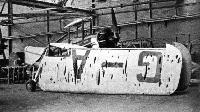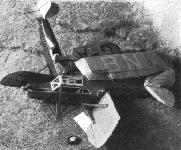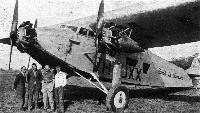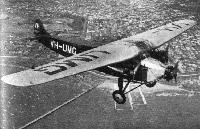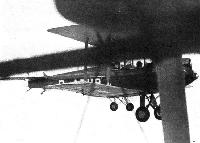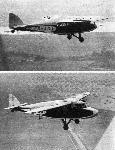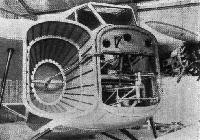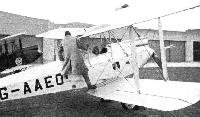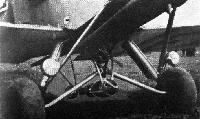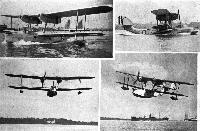Фотографии
-
CHEERIO!: Mrs. Patterson (in the cockpit of her "Hawk") receiving congratulations on gaining the "punctuality prize" at the Ladies' Meeting at Reading aerodrome last Saturday.
Самолёты на фотографии: Miles Hawk / M.2 - Великобритания - 1932
-
CLOSED IN: The latest and next edition of that popular light aeroplane, the Miles "Hawk," will have a cabin top, as seen in this sketch. The undercarriage will be of the single strut type - not so far seen in recent years in this country - and a tail wheel will be fitted. The first one (with a "Gipsy III" engine), which is being built for Mr. S. Cliff, should have a high cruising speed.
Самолёты на фотографии: Miles Falcon M.3 / Hawcon M.6 - Великобритания - 1934
-
BY EXPERTS: Mr. Fred Holmes' Avros ("Mongoose" engines) do some very polished formation flying.
Самолёты на фотографии: Avro Avro 504 - Великобритания - 1913
-
Регистрационный номер: PH-OST Самолёты на фотографии: Pander S-4 Postjager - Нидерланды - 1933
-
Harald Penrose in the cockpit of a Westland Wessex in the mid-'thirties. The Wessex was one of the diverse types tested by Penrose
Even when enclosed flight decks were accepted, however, there was a reluctance to abandon the open cockpit completely. In the Westland Wessex, for example, the windscreen could be opened to improve forward vision in fog or rain, and the entire cockpit roof opened upwards for emergency escape.Самолёты на фотографии: Westland Wessex / Westland IV - Великобритания - 1929
-
Регистрационный номер: G-ACIJ, W202 This view shows that there is no difficulty in flying the "Wessex" with one of the engines stopped. Actually we made a circuit of Heston Airport like this, climbing at quite a fast rate after the photograph had been taken.
Самолёты на фотографии: Westland Wessex / Westland IV - Великобритания - 1929
-
Michel Detroyat's Morane-Saulnier parasol monoplane
Самолёты на фотографии: Morane-Saulnier MS.230 - Франция - 1929
-
FOR THE BYRD ANTARCTIC EXPEDITION: The Curtiss-Wright "Condor," in which Admiral Richard E. Byrd will fly over the South Pole, flying over New York City. It is powered by two 700 h.p. Wright "Cyclone" engines, has a top speed of 170 miles an hour and a landing speed of 45 miles per hour.
Самолёты на фотографии: Curtiss Condor 18 - США - 1929
-
BYRD'S ANTARCTIC EXPEDITION: Rear Admiral Richard Evelyn Byrd tells his plans for the Second Expedition into the Antarctic wastes to an audience that gathered at the Boston Airport on September 29 for the christening of one of the Curtiss "Condors" he is taking with him. This plane, the William Horlick, has been named after one of the sponsors of the Expedition.
Самолёты на фотографии: Curtiss Condor 18 - США - 1929
-
Самолёты на фотографии: Fairey Gordon / Seal - Великобритания - 1931
-
Регистрационный номер: K2691 IN SQUADRON FORMATION: Fairey "Gordons" of No. 207 (Bomber) Squadron.
Самолёты на фотографии: Fairey Gordon / Seal - Великобритания - 1931
-
Регистрационный номер: K1167 CHANGING FORMATION: No. 207 Squadron changing from Squadron Formation to Echelon of Flights.
Самолёты на фотографии: Fairey Gordon / Seal - Великобритания - 1931
-
Регистрационный номер: K1756 READY FOR THE DAY'S WORK: Fairey "Gordons" ("Panther" engines) lined up on the aerodrome at Bircham Newton.
Самолёты на фотографии: Fairey Gordon / Seal - Великобритания - 1931
-
Регистрационный номер: J9067 PILOTS OF No. 207 (BOMBER) SQUADRON: From left to right, P Sgt. Mitchell, P/Sgt. Lawton, P O. Terdrey, F O. Bax, Flt. Lt. Ware, Sqd. Ldr. Vachell, Flt. Lt. Crummy, P/Sgt. Gould, and P/Sgt. Goodwin.
Самолёты на фотографии: Fairey Gordon / Seal - Великобритания - 1931
-
WITH AIR SERVICE TRAINING: A R.A.F. Reserve pilot alighting on Southampton Water at Hamble in a Saro "Cloud" amphibian.
Самолёты на фотографии: Saunders-Roe Cloud / A.19 - Великобритания - 1930
-
THE "TIGER MOTH" FIGHTER: The disc which was attached to the propeller for tests; the dispersion of the shots can be seen.
Самолёты на фотографии: De Havilland Tiger Moth / D.H.82 - Великобритания - 1931
-
THE "TIGER MOTH" FIGHTER: The gun mounting on the ejector side of the gun. The top chute is for the spent belt, and the larger chute for the used cartridges; the muzzle of the gun can be seen in front between the "V" strut.
Самолёты на фотографии: De Havilland Tiger Moth / D.H.82 - Великобритания - 1931
-
THE "TIGER MOTH" FIGHTER: The cockpit, showing the Aldis telescopic sight; the cocking handle is on the right and the trigger just behind the stick.
Самолёты на фотографии: De Havilland Tiger Moth / D.H.82 - Великобритания - 1931
-
Регистрационный номер: G-ACJV [2] MISS SOUTHERN CROSS: The Percival "Gull" ("Gipsy Major") used by Sir Charles Kingsford-Smith for his record flight to Australia.
Самолёты на фотографии: Percival Gull - Великобритания - 1932
-
Регистрационный номер: G-ACJV [2] KINGSFORD-SMITH'S AUSTRALIAN FLIGHT: Sir Charles Kingsford-Smith and his Percival "Gull" ("Gipsy Major"), Miss Southern Cross, in which he is making a flight to Australia.
Самолёты на фотографии: Percival Gull - Великобритания - 1932
-
It is difficult to imagine anything cleaner aerodynamically, than the Emerald when viewed from ahead.
Самолёты на фотографии: Dewoitine D.332 / D.333 / D.338 / D.620 - Франция - 1933
-
AIR-FRANCE AND I.A.T.A.: The French delegates to the International Air Traffic Association arrived at Croydon on September 26 in the new Dewoitine D.332. Left to right: MM. Oger Bajac, Chief Pilot, Air-France; Doret, Chief Pilot, Dewoitine; Briend, General Secretary, Air-France; Wooley Dodd, Manager, European Division, Imperial Airways; Allegre, Managing Director, Air-France; Burello, Second Pilot; Queyret, Wireless Operator; Crampel, Mechanic; Gavay, Bank of Indo-China; and Mr. G. MacKinnon, Arrow Aircraft Insurance Association.
Самолёты на фотографии: Dewoitine D.332 / D.333 / D.338 / D.620 - Франция - 1933
-
When necessary the Emerald can climb very steeply.
Самолёты на фотографии: Dewoitine D.332 / D.333 / D.338 / D.620 - Франция - 1933
-
Регистрационный номер: F-AMMY The passengers have large windows in the cabin of the Emerald.
Самолёты на фотографии: Dewoitine D.332 / D.333 / D.338 / D.620 - Франция - 1933
-
This shows the clean way in which the wing engines have been streamlined into the wing and undercarriage fairing. This latter forms an excellent shield to prevent the glare of the landing flares disturbing the pilot.
Самолёты на фотографии: Dewoitine D.332 / D.333 / D.338 / D.620 - Франция - 1933
-
FLAPPED: Mr. A. S. Gibbons, who has for some considerable time been a staunch adherent to the "Klemm," has now forsaken his "Pobjoy"engined machine for this new model with a "Gipsy III," which he has purchased from Herr Fretz, of "Swissair." As will be seen in our photograph, it has large flaps on the trailing edge of the wing which, in effect, materially increase the camber, so that slow landings and quick take-offs can be made. He tells us that he can cruise at about 125 m.p.h. and that his landing speed is very slow. Herr Fretz had this machine built for last year's Rund Flug.
Самолёты на фотографии: Klemm Kl.32 / Kl.36 - Германия - 1932
-
Mr. Lindsay Everard's D.H. "Dragon."
Самолёты на фотографии: De Havilland Dragon / D.H.84 - Великобритания - 1932
-
AFTER THE WEDDING: Lord and Lady Furness leaving Stag Lane for a flight in their D.H. "Dragon" (two "Gipsy Majors"), piloted by Mr. T. Campbell Black.
Самолёты на фотографии: De Havilland Dragon / D.H.84 - Великобритания - 1932
-
THE GOLD SEEKERS: The two D.H. "Dragons" which, as referred to above, will be used by the Western Mining Corporation for survey work in Western Australia.
Самолёты на фотографии: De Havilland Dragon / D.H.84 - Великобритания - 1932
-
Регистрационный номер: G-AAXE THE ALTERNATIVE AIRPORT: Weather conditions were too bad on Sunday for this Imperial Airways machine to land at Croydon, and so it made Heston its port of call.
Самолёты на фотографии: Handley Page H.P.42 / H.P.45 - Великобритания - 1930
-
Регистрационный номер: D-1786 FOR LUFT HANSA NIGHT SERVICE: The Junkers Ju.52.3m. (G 31 ???) which Deutsche Luft Hansa have put into operation on the night service between Berlin and Croydon during the winter.
Самолёты на фотографии: Junkers G 31 - Германия - 1926
-
"HOLEY": This happened on the ground in India, a country where they apparently get real hail storms.
Самолёты на фотографии: De Havilland Puss Moth / D.H.80 - Великобритания - 1929
-
Регистрационный номер: G-ABPE [2] RAMMED BUT REPAIRABLE: This crash occurred last week under convenient circumstances for our photographer to get this unique view. Luckily there were no lives lost. Close attention to the photograph will show that it is rather unusual in fact...
Самолёты на фотографии: Comper Swift / CLA.7 - Великобритания - 1930De Havilland Puss Moth / D.H.80 - Великобритания - 1929
-
Регистрационный номер: G-ABPE [2] TRUE TO LIFE: Scale models (pieced together after the crash) of a Comper "Swift" and a D.H. "Puss Moth."
Самолёты на фотографии: Comper Swift / CLA.7 - Великобритания - 1930De Havilland Puss Moth / D.H.80 - Великобритания - 1929
-
THE "GOLDEN CLIPPER" AT CROYDON: The Wibault Penhoet of Air-France about to leave for Paris. Owing to a confusion in the rate of exchange in the "Gold Standard" it was stated in our issue of September 21 last that the "Golden Clipper" was a Loire et Olivier - of course, the latter class are "Golden Rays." Just a little Golden Slipper on our part!
Самолёты на фотографии: Wibault Wibault 280 - Франция - 1930
-
391 M.P.H.: The Macchi seaplane (Fiat engine) on which the Italian pilot Cassinelli established a new world's speed record over a 100-km. closed circuit by averaging 629.37 km. per hr. (391 m.p.h.).
Самолёты на фотографии: Macchi MC.72 - Италия - 1931
-
THE LINDBERGHS IN ENGLAND: Col. and Mrs. Lindbergh flew from Norway to England on October 4. They are here seen after their arrival at Woolston, Southampton, about to go ashore - with the assistance of Maj. Brackley.
Самолёты на фотографии: Lockheed Sirius / Altair 8 - США - 1929
-
Регистрационный номер: VH-UXX [2] ANOTHER ENGLAND-AUSTRALIA FLIGHT: C. T. P. Ulm (second from left) and his companions, Allan, Edwards and Taylor, and the Avro X in which they are flying to Australia - hoping to better Kingsford-Smith's time.
Самолёты на фотографии: Avro Ten / Type 618 - Великобритания - 1928
-
Регистрационный номер: VH-UXX [2] The Faith in Australia and her crew, including Mr. Edwards (white sweater), wireless operator, who did not accompany Mr. Ulm!
Самолёты на фотографии: Avro Ten / Type 618 - Великобритания - 1928
-
Регистрационный номер: VH-UMG ON TASMANIAN SERVICE: The Avro "Ten" operated by Hart Aircraft Co., Ltd., on their Melbourne - Launceston service flying over Melbourne. The Hart Aircraft Company, whose offices and hangars are located at Essendon Aerodrome, Melbourne, operate as well as the Melbourne - Launceston service, a general aircraft engineering service, a taxi service throughout the Commonwealth of Australia and a school of aviation. Their flying equipment consists of the Avro "Ten" (three-engined monoplane), a Desoutter ("Gipsy Mark III"engine), a "Hawk Moth" with a geared "Lynx" engine, and two "Gipsy Moths."
Самолёты на фотографии: Avro Ten / Type 618 - Великобритания - 1928
-
SOME BRITISH VISITORS AT BUC: Mr. Gordon Selfridge Jnr. and Miss Von Treschow and their "Leopard Moth."
Самолёты на фотографии: De Havilland Leopard Moth / D.H.85 - Великобритания - 1933
-
FOR TRAINING: A row of Blackburn B2 Trainers used at the Blackburn School at Brough for training R.A.F. Reserve pilots. The machines are fitted variously with "Hermes" and "Gipsy" engines.
Самолёты на фотографии: Blackburn B-2 - Великобритания - 1931
-
Регистрационный номер: K3580 [2] THE AERIAL BATTLE CRUISER: The people in the background give a good idea of the size of the Blackburn "Perth."
Самолёты на фотографии: Blackburn Perth / R.B.3 - Великобритания - 1933
-
2,760 B.H.P. The Rolls-Royce "Buzzard" II MS. engines of the Blackburn "Perth."
Самолёты на фотографии: Blackburn Perth / R.B.3 - Великобритания - 1933
-
Регистрационный номер: K3580 [2] THE "CRUISER STERN": Note the gunner's tail defence position. The rudders are provided with servo flaps.
Самолёты на фотографии: Blackburn Perth / R.B.3 - Великобритания - 1933
-
AERIAL ARTILLERY: The Blackburn "Perth" flying boat is equipped with a 37-mm. gun firing shells weighing about 1 1/2 lb.
Самолёты на фотографии: Blackburn Perth / R.B.3 - Великобритания - 1933
-
WARMING UP: The central Rolls-Royce "Buzzard" engine is mounted on trestle struts, while the outboard engines are supported by the sloping interplane struts.
The Blackburn Perth (3 Buzzards) with side radiators on the nacelles.Самолёты на фотографии: Blackburn Perth / R.B.3 - Великобритания - 1933
-
PRINCE NICHOLAS IN ITALY: During his recent stay in Italy, Prince Nicholas of Roumania visited several aircraft factories. He is shown here in the front cockpit of a Breda 39 after flying this machine, accompanied by Ing. A. Colombo (rear cockpit). Standing on the left is Count Sagramoso, Managing Director of the Breda Company.
Самолёты на фотографии: Breda Ba.33 / Ba.39 / Ba.42 - Италия - 1931
-
THE "GIANT" AIR LINER: The H. P. "Clive" (two Bristol "Jupiters"), which attracted the crowd by virtue of its size, being refuelled from the specially designed National Benzole tank wagon.
Самолёты на фотографии: Handley Page Hyderabad/H.P.24 / Hinaidi/H.P.33 / Clive/H.P.35 - Великобритания - 1923
-
ORGANISATION: A unique view of Sir Alan flying a "Moth," taken from the cabin window of the "Clive" during the formation flight which was arranged over London on Saturday, October 7, to celebrate the successful conclusion of the National Aviation Day Display Crusade.
Самолёты на фотографии: De Havilland Gipsy Moth / Moth X - Великобритания - 1928Handley Page Hyderabad/H.P.24 / Hinaidi/H.P.33 / Clive/H.P.35 - Великобритания - 1923
-
Guy Hansez (Belgium) and his "Fox Moth"
Самолёты на фотографии: De Havilland Fox Moth / D.H.83 - Великобритания - 1932
-
Регистрационный номер: G-ABTK EN ROUTE FOR RANGOON: The Athena, of Indian Trans-Continental Airways, about to leave Calcutta, under monsoon skies, for Rangoon with the first Croydon air mails.
Самолёты на фотографии: Armstrong Whitworth Atalanta / A.W.15 - Великобритания - 1932
-
Регистрационный номер: G-ACJI THOROUGH flight testing to weed out any possible "snags" before going into production is the policy adopted by Short Brothers in connection with the little civil monoplane with two Pobjoy "R" engines. The above views were secured at Gravesend Aerodrome by our Chief Photographer recently when Mr. Lankester Parker was carrying out some tests. A deck fairing hap been added to the previously flat top of the fuselage behind the wing, but so far it has not been possible, owing to unfavourable weather conditions, to determine the effect of this fairing on performance, stability and trim. The tests are being continued.
Самолёты на фотографии: Short Scion / S.16 - Великобритания - 1933
-
ACCESSIBILITY: The nose of the new Short monoplane (two Pobjoy engines) is hinged so as to allow ready inspection and adjustment of the controls, instruments, etc. The machine is at present being thoroughly tested by Mr. Lankester Parker before deciding on production. That the machine is efficient is shown by the fact that, carrying three occupants for each Pobjoy engine, the top speed is in the neighbourhood of 115 m.p.h.
Самолёты на фотографии: Short Scion / S.16 - Великобритания - 1933
-
Регистрационный номер: F-AMEQ THE FARMAN 390: A Cabin Machine for Pilot and Three Passengers
Самолёты на фотографии: Farman F.190 / F.390 - Франция - 1928
-
A view (left) of the Hanworth cowling on one of the N.F.S. Desoutters ("Gipsy II"). This new clean design was made by the N.F.S. repair shops at Hanworth Park. On the right is shown another alteration to the N.F.S. Desoutter - the fitting of sliding windows to the passengers' cabin. These can be kept open in flight without undue draught entering the cabin.
Самолёты на фотографии: Koolhoven FK-41 - Нидерланды - 1928
-
Регистрационный номер: PH-AIZ [6] THE FOKKER F.XX : The slender fuselage has been made possible by adding the wing root depth to the cabin for headroom. The Wright "Cyclone" engines are enclosed in N.A.C.A. cowlings.
Самолёты на фотографии: Fokker F.XX - Нидерланды - 1933
-
Регистрационный номер: PH-AIZ [6] Самолёты на фотографии: Fokker F.XX - Нидерланды - 1933
-
Регистрационный номер: PH-AIZ [6] LOW FRONTAL AREA: The trailing edge flaps can be seen partly lowered.
Самолёты на фотографии: Fokker F.XX - Нидерланды - 1933
-
Регистрационный номер: PH-AIZ [6] THE CABIN, LOOKING AFT: There is comfortable seating accommodation for 12 passengers.
Самолёты на фотографии: Fokker F.XX - Нидерланды - 1933
-
Регистрационный номер: PH-AIZ [6] IN THE OFFICE: The dual controls and instrument board.
Самолёты на фотографии: Fokker F.XX - Нидерланды - 1933
-
Регистрационный номер: PH-AIZ [6] IN THE OFFICE: The wireless compartment. The large wheel operates the undercarriage retracting gear.
Самолёты на фотографии: Fokker F.XX - Нидерланды - 1933
-
Fokker F.XX 3 (640 hp.) Wright "Cyclone" Engines
Самолёты на фотографии: Fokker F.XX - Нидерланды - 1933
-
SOME BRITISH VISITORS AT BUC: Mr. Graham Mackinnon (right) with his pilot, George Reynolds (left) and Monospar.
Самолёты на фотографии: General Aircraft Monospar ST-4 - ST-12 - Великобритания - 1932
-
CLEANED UP: The Potez 50 used by Lemoine. In the actual altitude flight the N.A.C.A. cowling was not fitted.
Самолёты на фотографии: Potez Potez 50 - Франция - 1930
-
A POLISH-BRITISH COMBINATION: The P.Z.L.5 biplane, built by the Polish National Aircraft Factory of Warsaw, is fitted with a "Cirrus III" engine.
Самолёты на фотографии: PZL PZL.5 - Польша - 1930
-
Регистрационный номер: VH-UPB, ZK-ABW AMPHIBIOUS: The Saro "Windhover" amphibian (three "Gipsy II") leaving Melbourne en route for Launceston via King Island.
Самолёты на фотографии: Saunders-Roe Windhover / A.21 - Великобритания - 1930
-
Регистрационный номер: S1589 A SHORT VISIT TO SCOTLAND: The Short six-engined flying-boat which paid a visit to Kirkwall Bay on September 21.
Самолёты на фотографии: Short Sarafand / S.14 - Великобритания - 1932
-
Регистрационный номер: G-ABCC [4] ON TEST AT BROCKWORTH AERODROME: The Breda monoplane on which the Antoni variable camber wing has been mounted.
Самолёты на фотографии: Breda Ba.15 - Италия - 1928
-
Регистрационный номер: G-ABCC [4] THE STABILISERS: Near the wing roots the trailing edge is reflexed and flexible, and serves to give longitudinal stability.
Самолёты на фотографии: Breda Ba.15 - Италия - 1928
-
Регистрационный номер: G-ABCC [4] Mr. Ugo Antoni, the designer of the variable camber wing.
Самолёты на фотографии: Breda Ba.15 - Италия - 1928
-
Регистрационный номер: G-ABCC [4] IN THE TWO EXTREME POSITIONS: On the left, the wing is shown flat, while on the right it is shown in maximum camber position.
Самолёты на фотографии: Breda Ba.15 - Италия - 1928
-
THE ANTONI VARIABLE CAMBER SYSTEM: The upper and lower diagrams indicate the action of the wing, while the numbered sketches show the structural details at various points.
Самолёты на фотографии: Breda Ba.15 - Италия - 1928
-
Регистрационный номер: G-AAEO AT HATFIELD: In the foreground Mr. A. Irwin is getting into a "Moth" of the R.A.F. Reserve Flying Club, and on the left can be seen the nose of another "Moth" belonging to the Stage and Screen Aero Club.
Самолёты на фотографии: De Havilland Gipsy Moth / Moth X - Великобритания - 1928
-
EFFICIENT DESIGN: The "Scud II" sailplane designed by Mr. L. E. Baynes and built by E. D. Abbott ac Co., Ltd., of Farnham, won all the first prizes at the B.G.A. meeting at Thirsk on October 7 and 8, one of the best performances being the 15-mile flight of Mr. p. Wills, which won the Lord Wakefield Trophy for distance.
Самолёты на фотографии: Abbott-Baynes Scud - Великобритания - 1931
-
Регистрационный номер: PH-AJI [2] AERIAL ADVERTISING IN HOLLAND: A D.H. "Moth" ("Gipsy III") , with Dutch registration mark, used for advertising "Mercedes" cigarettes - which was written on the lower plane and also trailed out behind on a banner. Several flights have been made over Holland.
Самолёты на фотографии: De Havilland Moth Major / D.H.60GIII - Великобритания - 1932
-
Регистрационный номер: PH-AJI [2] FESTOONED: This undercarriage belongs to the "Moth" shown above, used by the Mercedes Cigarette Co., and was seen at the Heerlen Meeting in Holland. It has to carry four lights - two for landing, two for illuminating the lower plane - and two generators!
Самолёты на фотографии: De Havilland Moth Major / D.H.60GIII - Великобритания - 1932
-
The first machine constructed by Mr. Erasmus in South Africa.
Самолёты на фотографии: Erasmus SA-40 - ЮАР - 1933
-
Регистрационный номер: ZS-AEL The second effort of Mr. Erasmus
Самолёты на фотографии: Erasmus SA-40 - ЮАР - 1933
-
Mr. J. C. Erasmus, whose small machines are described on this page.
Самолёты на фотографии: Erasmus SA-40 - ЮАР - 1933
-
Регистрационный номер: S1648 THE SUPERMARINE "SCAPA": This is the name given to the production model. The prototype was known as the Supermarine "Southampton IV." The engines are Rolls-Royce "Kestrels"
Самолёты на фотографии: Supermarine Scapa - Великобритания - 1932
-
The Wien glider of M. Henry Lumiere, President of the Aero Club of Rhone and South West.
Самолёты на фотографии: Lippisch / RRG Wien - Германия - 1929
Статьи
- Flight
- Flight Advertisements































